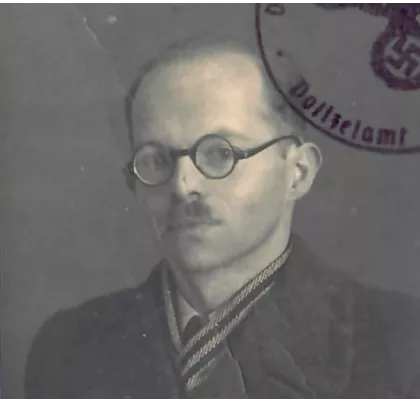Heinrich (Jindřich) Rimpel (1906-1979)
The photographer who moved to Prague
Heinrich Rimpel, known as Hobby, was born on 10 March 1906 as a German-speaking Jew in Mährisch-Ostrau (Ostrava) in Austria-Hungary, in the east of what is now the Czech Republic. He grew up as an only child in a rather religious and wealthy family. His parents, Jakub Juda Rimpel and Josefa Rimpel (later Rimpelová), owned a tenement house in which they ran a general shop.
- © Privat
Heinrich Rimpel attended a secondary school and studied architecture and civil engineering in Brno and Prague after graduating from high school. He was in the military during his studies and graduated in Prague around 1930. After graduation, he worked in various architectural offices in Ostrava and Prague and participated in a lot of sports: fencing, hockey and athletics. In the early 1930s, he met his future wife Marketa (Margarethe, known as Grete) Leknerová at a Jewish sports club in Prague; they married in October 1936. In addition to sport, they loved music and were active in a left-wing Jewish club, where they listened to political lectures and went on trips to the Prague countryside with the other members.
After the occupation of Bohemia and Moravia by the Germans on 15 March 1939, Heinrich Rimpel lost his job and from then had to eke out a living as a carpenter. He later managed to obtain visas for Shanghai, but because his wife did not want to leave her mother behind, all three decided to remain in Prague. At the beginning of December 1941, Heinrich Rimpel was deported to the Theresienstadt ghetto on one of the first transports. His wife and her mother followed him six months later. His mother-in-law died in May 1943 at the age of 70 due to the terrible conditions in the ghetto.
In March 1944, due to his manual skills Heinrich Rimpel was sent to build the Wulkow satellite camp in the province of Brandenburg and remained there until the camp was abandoned in February 1945. Immediately after his return to Theresienstadt, he was assigned to a labour detachment in a satellite camp in Schnarchenreuth (near Hof) in Bavaria, from where he had to make his way back to Theresienstadt on foot a short time later. (This was a so-called death march.) He reached Theresienstadt where he and his wife were liberated by the Red Army on 08 May 1945. He later learned that his parents had been murdered on 28 October 1942 immediately after their arrival in Auschwitz; he had lost countless other relatives and friends in the Shoah.
- © Privat
After the liberation, Heinrich Rimpel and his wife Margarethe returned to Prague, where Heinrich later worked in the office of the Jewish community. Their son Tomaš was born in 1946 and their daughter Věra in 1949. From 1947, Heinrich Rimpel worked for the trade unions as an architect, building and renovating recreation centres for workers. As part of his work, he was also able to pursue his hobby: He was a passionate photographer and photographed the local landscapes on his work-related travels. From the 1960s onwards, he struggled with heart problems - presumably caused by persecution - which forced him to reduce his working hours and eventually retire early. During these years, he focused his photography work on his adopted hometown of Prague.
When both children went to West Germany after the invasion of the Warsaw Pact troops in 1968, Heinrich and Margarethe Rimpel were able to follow them to their daughter's wedding in December 1969, as they had already retired. They ended up staying in Bremen, close to their daughter and her family. They were never allowed to visit their homeland again after moving to West Germany. As "ethnic German resettlers", they were granted German citizenship and later received compensation payments from the German state in addition to their regular pension. However, Heinrich's health problems were not considered eligible for compensation - a connection to his persecution could not be substantiated.
- © Privat
Heinrich Rimpel lived in Germany in constant fear of accidentally encountering the sadistic camp commandant of Wulkow, Franz Stuschka, or other Nazi perpetrators on the street. The memories of the time of persecution repeatedly featured in his nightmares. After suffering two heart attacks, Heinrich Rimpel died on 26 February 1979, shortly after proudly witnessing the birth of his second grandchild. He was buried in the Jewish cemetery in Bremen-Hastedt.
Heinrich's photos returned to Prague in 2006 on the occasion of his 100th birthday as part of an exhibition organised by his children.
- © Privat

